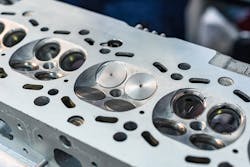Using AI to Define Alloys for Performance Targets
Manufacturing processes are largely predictable, which leads to reproducibility and frequently to scalability. Eventually, it leads to experience for those who oversee these processes. Experience is less valuable in manufacturing today than it used to be because it’s a less predictable route to success — only incidentally scalable and reproducible only with time and effort. The current state of manufacturing relies on a different route. Artificial Intelligence (AI) is helping manufacturers accelerate the time and reduce the cost of developing experience, possibly to arrive at insights that experience may never reveal.
Scientists in Japan have developed a way to use AI, or machine learning, to understand details of material science and metallurgy before manufacturing has even begun. Their approach, published in Science and Technology of Advanced Materials, predicts the elements and manufacturing processes necessary to produce aluminum alloys with specified mechanical properties.
While the published details address work with 5000, 6000, and 7000 series alloys, the approach the authors describe could be applied to any alloys for which reliable records are accessible, and may lead to developing new alloys for desired applications.
In “Materials Informatics Approach to Understand Aluminum Alloys,” Ryo Tamura and colleagues at Japan’s National Institute for Materials Science and Toyota Motor Corp. explain the technique they have developed that draws available data from aluminum alloy databases and feeds these into a machine-learning model.
While there is data available on alloy performance accumulated through process simulations, the new technique seeks to achieve a “macroscopic viewpoint” by also incorporating data from experiments in materials science. The effect is to create insight to the interactions between alloy properties, compositions, structures, and processes.
“First, we train a machine-learning prediction model for the mechanical properties when process parameters and compositions of elements are inputted,” they write. “Here, the prediction model with the highest prediction performance is selected from some supervised machine-learning models. Second, the distributions of the process parameters and element compositions based on the prediction model are investigated to obtain the desired mechanical properties.”
The strategy applies the Markov chain Monte Carlo (MCMC) method: a series of algorithms that obtains samples of a desired distribution of results by recording states from the sequence; the greater the number of sequences that are included in the field, the more closely will the distribution of the sample match the actual desired distribution.
The third step of the process is drawing out factors for the desired mechanical properties of an alloy. “Our technique finds the relations hidden in the aluminum alloy databases, which are difficult to discover by simple correlation analysis,” Tamura et al. write.
It bears repeating that this is done without the input or supervision of human intelligence or experience. The human input in the manufacturing process now is to set the targets for AI-guided research.
While aluminum alloys provide the lightweight quality that automotive designs now require, the model was able to project that 5000 series alloys that are more resistant to stress and deformation can be produced by reducing the percentage of aluminum and elevating manganese and magnesium levels.
The research paper describes target aluminum databases for 5000, 6000, and 7000 series as well the results for those alloys using the AI technique. It may not replace the value of experience in operating practice, but it may provide more predictability to manufacturers, before manufacturing begins.

